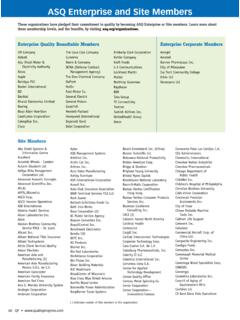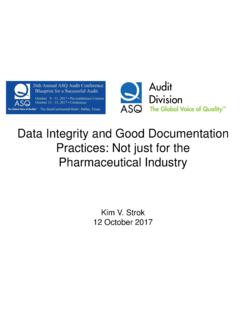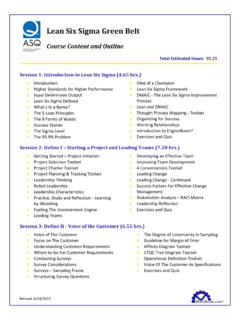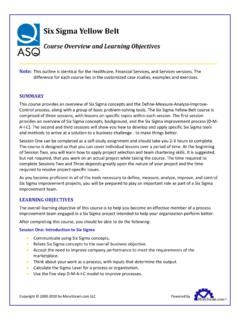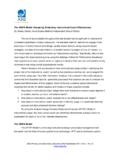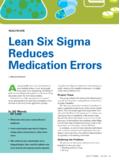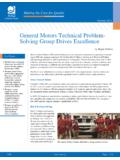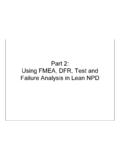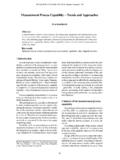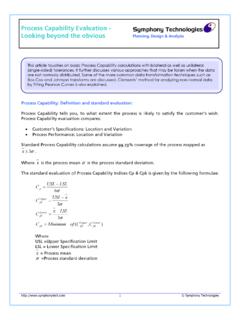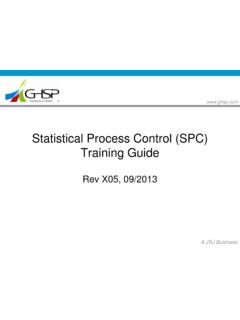Transcription of Cpk Plots – An Application of Individuals Control …
1 22 ASQ STATISTICS DIVISION NEWSLETTER, VOL. 18, NO. 2 Continued on page 23 TUTORIALCpk Plots An Application of Individuals Control ChartsRobert Mitchell, 3M CompanyIn a previous issue of the Statistics Division Newsletter, I introduced readers to a variety of process capability indices used today inindustry. In this article I offer a case study on how an Individuals Control chart is used to track Cpk as a means of measuring ongo-ing process improvement activities. Recall that Cpk is defined as:Cpk = minimum of {Xbar - LSL, USL Xbar }where = process standard deviation3 3 Practitioners often forget that process capability indices are merely point estimates obtained by taking samples from a one must report Cpk (many customers now require Cpk for key quality characteristics on suppliers Certificates of Analysis), thenone must understand the associated errors of sample size and other related limitations and constraints in estimating Cpk.
2 First, Cpkshould only be estimated for a stable process . A process lacking statistical Control is not predicable. In such cases Ppk is the morecorrect estimate of process = minimum of {Xbar - LSL, USL Xbar }where s = sample standard deviation3s 3sSecond, Cpk (and Ppk) estimates of population capability assume the data come from a normal (or bell-shaped) distribution, withsymmetrical specification limits about the target. Because process capability indices are determined from estimates of standarddeviation, they are affected by sample size (degrees of freedom). As expected, the standard error of the estimate of Cpk decreasesas the sample size can be shown by use of the Chi-square distribution and Monte Carlo simulation techniques that a sample size (n) as small as 10cannot be relied upon to give results of much practical value.
3 Even whennis as large as 40 there is still substantial uncertainty inthe estimator of Cpk. Table 1 provides an estimate of the 95% lower bound on the sample Cpk, for various known population (orlot) capabilities (assuming the data follow a normal distribution). Table 2 shows confidence intervals for 1. Approximate 95% l o w e rCI for Cpk. (1)Table 2. Approximate 95% Confidence Interval for Ppk.*As Table 1 shows, a stable process possessing a true process capability of could exhibit a sample Cpk value as small as ,even when the sample size is as large as 30. Although not usually of interest, a similar approach would illustrate that the sampleCpk could be much larger than the population Cpk These points are important to note with regards to shipment Certificates ofAnalysis (CoA) required by your customer.
4 Small sample sizes could result in a capable shipment appearing to be not capable ofmeeting customer specifications, but only because the sampling variability allows the sample estimate of Cpk to be much smallerthan the population or lot characteristic (referred to as producer s risk ). But also, an incapable shipment could appear capablebecause the sampling variability allows the sample Cpk to be larger than the population or lot characteristic (referred to as con-sumer s risk ). Because the sampling distribution of the Cpk statistic is so variable it should not be used unless relatively large sam-ple sizes (100~200) are obtained. If Lot Cpk is requested on a shipment CoA the supplier should pull in historical data to get thesample size (for Cpk estimates only) greater than 100. Similar variability in Ppk is illustrated by Table with any process data, Cpk estimates are better understood and interpreted when they are plotted over time.
5 To avoid the pit-falls of making decisions based on 2-point comparisons and of single sample variation the concepts of Statistical Thinking shouldbe employed and Cpk values plotted on Control charts. A graphical plot of Cpk assists in the visual summarization of processimprovement (or deterioration). The following example illustrates both common cause variation in Cpk and special cause variationin Study: Slit Roll Tab ControlA key quality characteristic for the starter tab on a roll of office tape must be controlled to target, with minimal results in a flagged tab which causes roll unraveling and strand entanglement in the automated conveying Size Used toEstimate STATISTICS DIVISION NEWSLETTER, VOL. 18, NO. 223 TUTORIALC ontinued from page 22ment; whereas, overtabbing causes end-user frustration due to difficulty starting the roll.
6 In essence we have identified an Internalcustomer need for equipment efficiency, and an External customer need for ease of use. The parties agreed that this need mightbe summarized by requiring a Cpk of or greater. An Individuals Control chart of Tabbing Cpk, (how well the starter tab isplaced to the correct length on the roll of office tape), given below, shows the affect of slitting and winding process modificationsover time. The Individual Value reported on the y-axis is the Cpk statistic calculated for the month. The monthly sample size wasset at n=100 in order to minimize the effect of sampling variation in the estimate of sigma for the Cpk 3-sigma Control limits on the Individuals chart are determined from the historical Moving Range of the monthly averages. Thelimits were then fixed about the process mean.
7 The centerline was adjusted only after we had determined that the process shiftwas indeed attributed to our process modifications, and only after we were comfortable that the change was permanent.(Remember we are collecting a minimum 100 Tab Length measurements per month). During the first five months of charting thiskey quality characteristic of the tabbing process was in- Control (predictable) but not capable of meeting tab length specifications, Cpk was less than A cross-functional team of operator, maintenance, and process engineers was formed to improve thetabbing capability . Possible causes for the tabbing variation were brainstormed and prioritized. process capability was plotted overtime as process modifications were implemented. The monthly chart of Cpk clearly illustrates that the installation of new drivesraised the process capability from the vicinity to the vicinity, and we knew that this special cause change (Cpk values out-side the former limits) was significant.
8 Similarly, the next change (unwind brake) was illustrated to have raised the process capa-bility from the vicinity to the vicinity; and the new controller raised it further to the vicinity. The most recent change(reworked bars) is still being evaluated. Note that the decisions as to whether Cpk has improved and whether it meets the are not based on a single value but rather on a collection of values, and the graphical representation helps visualize thesej u d g e m e n t s .Through the use of this process behavior chart on Cpk we have been able to quickly and easily display the effect of variousprocess changes on process capability , and to illustrate whether these process changes resulted in significant changes in Cpk (spe-cial cause) or merely random changes in Cpk (common cause).
9 However, although the Individuals Control chart of Cpkvalues helps illustrate process improvements over time and differentiate Special cause from Common cause variation month tomonth, it does not show the short-term underlying stability of the roll tabbing process . In other words, though a Cpk value c a nb ecalculated, is the underlying process stable and in a state of statistical Control (a requirement of Cpk)? Tab Length X-bar andR charts were maintained by production operators in order to verify that the new process was stable, following each of the aboveprocess changes. The estimates of Cpk were then summarized monthly by the process engineer and used in the above U M M A R YCpk values are estimates (statistics) calculated from a sample and used to estimate a population characteristic.
10 These estimates aresubject to variation (sampling variability). The larger the sample used to estimate Cpk, the smaller the variation in that estimate. Asimple Control chart can be used to illustrate this random variability in Cpk , and to help us identify when process changes haveresulted in significant improvements in process capability . Reference: (1) Franklin, L. A. and Wasserman, G. S., Bootstrap Lower Confidence Limits for capability Studies , JQT, Vol. 24 No. 4. andQuality Assurance for the Chemical and process Industries, 2nd edition, (ASQ Quality Press).

